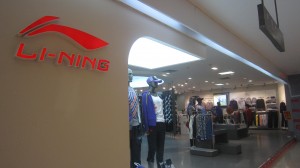When news about the fake Apple store in Kunming China broke out, it further reinforced the image of China as the Mecca of knock-offs. From 50 renminbi (RMB) for a pair of Ray Bans to 10 RMB for a DVD, fake goods are ubiquitous in China. Virtually every city has a fake goods market with merchants lined up in stalls, shouting ‘hello’ to the nearest foreigner and lighting bags on fire to prove the authenticity of their leather. The case of the fake Apple store reflects a copying culture that is very common and part of popular culture. The global attention the country receives elicits more laughs than shame from ordinary Chinese.
Even native brands – that target the Chinese market – struggle to find their own voice and borrow heavily from the west. Li Ning, a maker in sports apparel and active footwear, is one of the most successful domestic brands in China and competes with the likes of Nike and Adidas. It is however a mirror image of Nike. I mean literally, flip Nike’s logo and you got Li Ning Ltd. Its slogan also captures the same drive and ambition in Nike’s Just do it, with its mantra, Anything is Possible. Although in July, the company did introduce a slightly altered logo and a new slogan, Make the Change – as you can see it’s a real game changer!
China’s current development strategy relies on a number of joint ventures with foreign companies, with its main objective being to secure knowledge and technology transfers. For instance, the development of China’s high-speed railway network led to a competitive bidding war among foreign companies, among them included Canada’s Bombardier. A major criticism in the aftermath of the train crash in Wenzhou is that quality, oversight and safety were compromised as the Government sought to accelerate the expansion of high speed railways and adopt foreign technology to in turn allow Chinese companies to innovate and export the technology. The Chinese, it seems, have been successful in appropriating the technology. Chinese companies have already helped with the development of high-speed rails in India and Brazil.
In response to the widely acknowledged copying culture, the Chinese education system is often blamed for failing to breed creativity and innovation. The test-based education system (应试) creates a generation of young people who are superior test takers. Beginning with primary school, the educational experience focuses on preparing students for a series of entrance exams, the most important one being the annual National Entrance Exam (高考). The education system tends to overemphasize the use of tests to evaluate performance and rewards rote memory over critical thinking.
So, when it comes to the China threat question, the lack of innovation and the human capital and technology gap are major hurdles to the country’s rise. However on the other hand, while Lining is not likely to compete with Nike in the global market in the near future; and neither will brands like Haier or Tsingdao replace GE or Budweiser, they can potentially edge out foreign brands in the domestic market and in other non-Western markets.
Many Chinese brands are making a name for themselves in Southeast Asia and the Middle East. Years of having American cars like Jeep sell to the Chinese market has led to the growth of Chinese companies, like Chery who are seeing significant growth in the Middle East and North Africa. While I was travelling in Anji, home to a vast bamboo forest, I visited a clothing wholesaler whose wide collection of active wear, sleep wear and even business wear are made out of bamboo. I assumed they were a supplier for Chinese retailers, but a sales rep proudly explained they were well-established in Southeast Asia and had buyers in France. It was certainly ironic that the country with the largest C02 emissions is able to produce a green eco-friendly company that has the capacity to tap into the European market.
There is no doubt that fake Guccis and Burberrys are aplenty in China. But the rise of domestic Chinese brands signals an important and major step in the country’s development. And although these brands tend to be an import of western ideas rather than a distinctive approach to attract the Chinese middle class, one does have to credit them for being sophisticated replicas. And in the area of technology, the import of foreign goods may eventually lead to their demise. The Chinese are acutely aware of their global image as a factory of cheap goods and their desire to change it is just as apparent.
While both Chinese and Westerners scoff at the fake Apple store, it is easy to be dismissive and overlook that counterfeiting and copying is perhaps more of a phase in the economic growth of native Chinese firms. It may also represent the conduit to the country’s future innovation and success.
Image Credit: Palmo Tenzin

